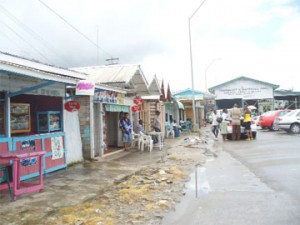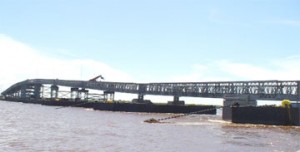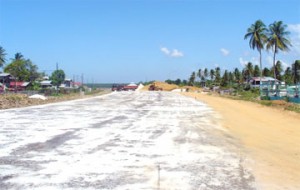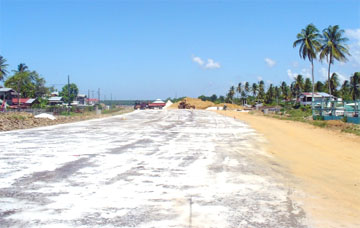Story and photos by Shabna Ullah
Amid anticipation for the completion of the Berbice River bridge some persons are fearful that they would become unemployed as operations at the Rosignol and New Amsterdam ferry stellings would be reduced.

Already, workers from the Transport and Harbours Department are pondering their next move though they are optimistic that they “would make it. As long as we get we pay off we can go and invest in a business.”
When the bridge opens it would no longer be economical for the MV Makouria and the MV Torani to operate in Berbice. Transport Minister Robeson Benn, in an invited comment, told Stabroek News that the ferries would be sent to ply the Essequibo River. However, the pontoon MB Sandaka would operate the Rosignol to New Amsterdam route six days per week. The minister said the pontoon would also be used weekly “to resume the services in the Berbice River as a way of reviving agriculture” as farmers have long complained about the difficulties of transporting their produce from the area.
Revenue
Stabroek News understands that the Berbice ferry rakes in revenue amounting to millions of dollars per day. The vessels, which were built in the 1950s, have the capacity to hold 1,200 passengers and 30 cars or 15 trucks each. A study conducted by the transport sector a few years ago had said that about “2.3 million passengers, 200,000 vehicles and 100,000 tonnes of freight are carried every year, with 48 trips per day, per direction…”
Initially, only the Torani operated between Rosignol and New Amsterdam. However, on completion of the Demerara Harbour Bridge in 1978, ferry services across the Demerara River were reduced and the Makouria was sent to Berbice.
Commuters hope that the Berbice ferry service would eventually be completely replaced by a speedboat service as was the case a few years after the Demerara Harbour Bridge was built. But according to an official from the THD “so far there are no plans for that.” Meanwhile, some commuters — workers and schoolchildren — plan to continue using the ferry service, which to them “would be far cheaper.” The cost of a single-crossing ticket at the stelling is $60 for adults and $40 for children. On the bridge, small vehicles would be required to pay a toll of around $1,500; almost the same as the return crossing with the ferry.

Recently, Berbice minibus and hire car drivers increased their fares by up to $200 for long distances owing to the high cost of fuel. Already passengers are bracing themselves for another increase because of the bridge tolls and the added costs to change transportation to get to their destinations. However, most commuters said they would not mind paying extra. They are eagerly awaiting the opening of the bridge as “the hassle and long wait at the stellings would be over.”
Some vehicle owners have said that drivers are forced to pay a “bribe just to get on the boat.” This had prompted President Bharrat Jagdeo to dissolve the priority crossing system after receiving complaints about its abuse. However, this obtained only for a short time as the priority crossing and abuse has continued.
No job
Meantime, persons working at snackettes near the Rosignol and New Amsterdam stellings are concerned that they may soon be jobless. Some single mothers at Rosignol told Stabroek News that though they have worked at the snackettes for over 15 years they have not been able to save any money to start their own businesses as their salaries were barely enough for them to survive. The women said “getting another job would not be easy… we don’t have much job opportunities in Berbice; we would find it hard.”
At the same time, the snackette owners have said that they would not be able to keep their staff because they depend mainly on commuters who use the ferry to support their businesses. One snackette owner who has been in the business for over 20 years said, “I don’t even know if I would make enough money for myself much less to pay staff… I started out life selling here and I don’t want it to end like that.” The woman is calling on the authorities to provide them with spots closer to the bridge so that they could continue their trade.

Another woman said that just before the bridge project started, “two persons came around and they took pictures of the stalls and promised we that we would get somewhere close to the bridge to sell. But we never hear from them again… We have to get something else to do.”
The approach roads for the bridge are located at D’Edward, West Coast Berbice and Palmyra, East Canje and business persons outside these areas believe that they would be shut out from the “hive of activities.” They said while they too are happy for the bridge the reality is that they would face a “massive reduction in sales.”
Boost to the economy
However, Rohan Marray, a New Amsterdam businessman and past president/secretary of the Berbice Chamber of Commerce and Development Association was optimistic that the bridge would not affect adversely businesses but would instead be a boost to the economy. He told Stabroek News that he didn’t see the location of the bridge as problematic “because if people need items they would still have to come to New Amsterdam…” He said the bridge would be much more convenient than the “unreliable and inefficient ferry service and I hope that it would be finished as quickly as possible so we can get the use of it.”
Vehicles are sometimes forced to wait for as long as five hours before they are able to board the ferries to their destinations. This newspaper understands that this often happened even when the pontoon was employed together with one or both of the boats. Minibus and taxi drivers also complained that they would “feel the squeeze” as they depend mostly on passengers who cross with the ferry. One minibus driver at the Rosignol, suggested that the Route 63 ‘A’ minibuses should take passengers up to a specified point, instead of all the way to Georgetown.
The bridge was expected to be completed last month end but an official told this newspaper that this deadline has since been extended to October month-end. Seventeen of the 39 spans have been installed on the bridge and the high span and the sloping spans have also been completed. The first and second spans have been left out to prevent persons venturing onto the bridge but this newspaper understands that the pontoons to accommodate these spans were expected to be assembled over the weekend.
The retractor span is the last section that will be installed and, according to the official it has been affected by a five-week delay in shipping. The components for this section had been shipped from England since June 2 by European West Indies Lines but the cargo was returned to England after the company went bankrupt on July 14. The source said the container has since been reloaded onto the Eastern Caribbean Lines, which departed one week ago. In the meantime, the abutment on the western side of the bridge has been completed while piles are being driven on the eastern side for the abutment. Dipcon Contracting Company has been contracted “to build a revetment to protect the abutment.”
Road project
An official of Dipcon said that the company has started working late at night to complete the job on time given setbacks because of the rainy weather. Dipcon was awarded the US$8.7 million contract for the road project.
The official said that 75% of first layer of reed sand has been placed on the eastern end of the road but rain has been preventing the spreading of more sand. At D’Edward, the prime-coat has already been laid and was awaiting the consultants’ approval before the asphalt is applied.

